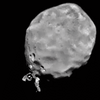GreyCrow
TheBrownDog
- Mar 21, 2016
- 74,936
- 119,204
- AFL Club
- Adelaide
- Other Teams
- Sturt, White Sox
Not sure how new ( to Netflix) it is but a 1hr doco on the concept and construction of James Webb is up
Follow along with the video below to see how to install our site as a web app on your home screen.
Note: This feature may not be available in some browsers.
India just landed a spacecraft on the moon what an awesome achievement for them!

Glad they didn't let their last failure halt their efforts!The rover is now off and running.
Brilliant work by the ISRO. Done on a shoestring.
Amazing Footage Shows Indian Rover Ramping Down to the Lunar Surface
A fascinating new video released by the Indian space agency show the country's lunar lander rolling down to the surface.futurism.com
Wonder what the uber charge would be?The rover is now off and running.
Yes, the gag was there. The other day I managed to get the 'Don't call me Shirley' response from a poster, for which I was very grateful.Wonder what the uber charge would be?
(C'mon it was there)

 theconversation.com
theconversation.com




 www.forbes.com
www.forbes.com
Arent these ( burning terrestrials) just in different stages of their own evolution? Or at the end?Our solar system is increasingly looking unusual, some common exoplanet types we don't have include superearths, warm gas giants, water worlds and this last group, the burning terrestrials or lava worlds.

Half Of All Rocky Planets Are Strange ‘Burning Worlds’ Of Lava, Say Scientists
A new study reveals secrets about the mysterious planets where molten lava flows on the surface—one of the most common types of exoplanets so far discovered.www.forbes.com
Just the diversity of planets and moons in our solar system is amazing.Our solar system is increasingly looking unusual, some common exoplanet types we don't have include superearths, warm gas giants, water worlds and this last group, the burning terrestrials or lava worlds.

Half Of All Rocky Planets Are Strange ‘Burning Worlds’ Of Lava, Say Scientists
A new study reveals secrets about the mysterious planets where molten lava flows on the surface—one of the most common types of exoplanets so far discovered.www.forbes.com
In term of their origin, I would guess it's the same as other terrestrials, they just ended up very close their star, some with fast orbits of days, others tidally locked, in both instances getting nice and toasty. Same origins, different evolutionary paths because of orbital location. Like the real estate agents say, location, location, location.Arent these ( burning terrestrials) just in different stages of their own evolution? Or at the end?







SBS had a doco on last night. Same one?Not sure how new ( to Netflix) it is but a 1hr doco on the concept and construction of James Webb is up
I don't suggest you check that illusion, there are many Russians who can attest to the deadly reality of gravity. Gravity was also the challenge for SpaceX and the second launch of Starship. It did better this time, it didn't destroy the launchpad, the 1st stage fired successfully and the second stage separated doing a 'hot launch' and it got to about 150kms and 25,000kmh. Alas, the booster exploded shortly after separation and the 2nd stage lost contact 9 minutes into the flight, most likely due to self destruct activation.SBS had a doco on last night. Same one?
I've been listening to quite a few astrophysics podcasts & YouTube videos lately. Gravity as an illusion is a very interesting concept.

I'd say it might take more than a couple of exploding rockets to disprove Einstein's life workI don't suggest you check that illusion, there are many Russians who can attest to the deadly reality of gravity. Gravity was also the challenge for SpaceX and the second launch of Starship. It did better this time, it didn't destroy the launchpad, the 1st stage fired successfully and the second stage separated doing a 'hot launch' and it got to about 150kms and 25,000kmh. Alas, the booster exploded shortly after separation and the 2nd stage lost contact 9 minutes into the flight, most likely due to self destruct activation.


